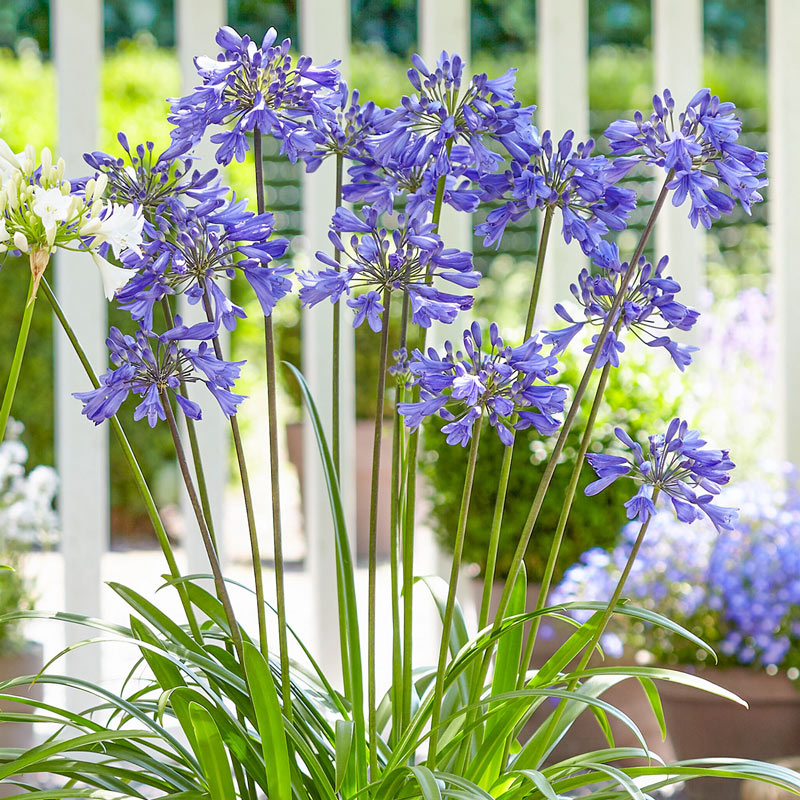Usual Agapanthus Issues and Exactly How to Resolve Them
Wiki Article
Understanding the Art of Agapanthus Treatment: Necessary Steps for Healthy And Balanced Development and Dynamic Flowers
In the realm of cultivation, the cultivation of agapanthus stands as a satisfying endeavor for those who seek to support these classy flowering plants. With their striking blooms and elegant foliage, agapanthus has recorded the interest of gardeners worldwide. Nonetheless, attaining ideal development and dynamic blossoms calls for a nuanced approach that encompasses various crucial steps. From selecting the ideal selection to understanding pruning strategies, the journey towards growing thriving agapanthus plants is multifaceted and holds the key to opening the full possibility of these organic gems.
Picking the Right Agapanthus Range

When selecting the right Agapanthus variety for your garden, consider factors such as environment suitability, flower color, and development practice. In addition, consider the environment in your area to ensure the Agapanthus selection you choose can thrive in your details conditions. Recognizing the growth behavior of various Agapanthus selections is essential for correct placement within your garden.
Suitable Planting Problems
Thinking about the ideal ecological demands is essential for effective Agapanthus cultivation. Agapanthus flourishes in well-draining dirt with a slightly acidic to neutral pH level. When growing, pick an area that gets full sunshine to partial shade. In hotter climates, offering some afternoon color can avoid scorching of the leaves. Agapanthus plants are sensitive to cool temperatures and must be shielded from frost during winter season.To make certain healthy and balanced growth and vibrant blooms, plant Agapanthus light bulbs at a depth of about 2-4 inches and area them 8-12 inches apart. Mulching around the base of the plants helps retain wetness and suppresses weed development.
Watering and Feeding Tips
Maintaining appropriate dampness degrees and providing important nutrients are vital elements in the care regimen for Agapanthus plants. When it comes to sprinkling Agapanthus, it is important to strike an equilibrium. These plants like consistently damp soil however are at risk to root rot if overwatered.Feeding Agapanthus is crucial for promoting healthy development and respected blooms. Use a balanced fertilizer, such as a 10-10-10 formula, in the early spring as new development arises. By following these watering and fertilizing tips, you can guarantee your Agapanthus plants thrive and create navigate here lively, resilient blossoms.
Trimming Methods for Agapanthus
Pruning Agapanthus plants at the ideal times and with appropriate methods is vital for keeping their wellness and promoting optimum growth and blooming. The optimal time to prune Agapanthus is in late winter season or very early springtime before new growth emerges.For flowered stems, wait until the blooms have actually withered and after that cut them back to the base. This not only cleans the plant's look yet also motivates the advancement of new blossom buds. Deadheading spent flowers can also reroute the plant's energy right into producing more blossoms instead of setting seeds. However, if you wish to collect seeds for breeding, leave some flowers to completely dry and mature on the plant.
Remember to use tidy, sharp tools to make specific cuts and decrease the risk of introducing diseases. Agapanthus. Regular pruning will certainly help maintain your Agapanthus looking cool and healthy while making certain a bountiful screen of stunning blooms
Managing Typical Parasites and Diseases
After making sure appropriate pruning techniques for Agapanthus, it is vital to deal with usual parasites and diseases that can influence the wellness and vigor of these plants. Agapanthus plants are generally sturdy however can still come down with certain concerns. One common insect that impacts Agapanthus is the Agapanthus gall midge. This little, orange fly lays its eggs in the foliage, leading to altered growth and flower buds that fall short to open up. To combat this parasite, trim and destroy any damaged plant parts and think about utilizing insecticidal soap.Additionally, Agapanthus plants can suffer read this post here from origin rot if they are grown in poorly draining pipes dirt. By being alert and taking prompt activity versus parasites and illness, you can aid your Agapanthus plants flourish and produce vivid blooms. Agapanthus.

Verdict
In conclusion, grasping the art of agapanthus treatment involves selecting the right selection, supplying suitable growing problems, appropriate watering and feeding, appropriate trimming strategies, and attending to typical insects and conditions. By adhering to these crucial actions, you can make certain healthy and balanced development and dynamic flowers for your agapanthus plants. Keep in mind blog to routinely keep track of and preserve your plants to promote their overall health and durability.To make sure healthy growth and lively flowers, plant Agapanthus bulbs at a depth of regarding 2-4 inches and space them 8-12 inches apart. By adhering to these watering and feeding ideas, you can guarantee your Agapanthus plants grow and produce vibrant, lasting blooms.
One usual parasite that affects Agapanthus is the Agapanthus gall midge. Additionally, Agapanthus plants can experience from origin rot if they are planted in badly draining dirt. By complying with these essential actions, you can ensure healthy and balanced growth and lively flowers for your agapanthus plants.
Report this wiki page